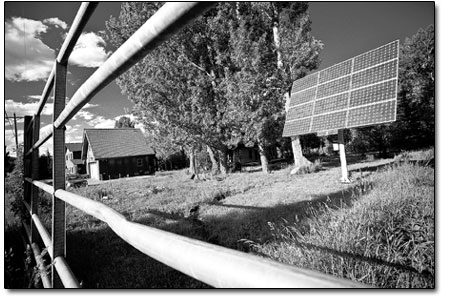| ||||
The green retrofit
by Anna Thomas Depressed housing market Economic downturn. Mortgage crisis.These are the buzz words of the current state of the American Dream. So many people in Durango yearn to be able to afford a house in the town they love, but in the end, it seems like an uphill battle. Especially for those who want to do right by the environment and by the health of their families by going “green.” There is hope, however. The proliferation of green options, from green builders, green retrofitting incentives, even green real estate agents, is the light at the end of the long, dark tunnel on the road to home ownership. For those who already own their home, the option of green remodeling represents a way to increase the value of their existing home, both financially and aesthetically, while giving the environment some badly needed TLC. Perhaps due in part to the indefatigable nature of the American spirit, traditional avenues in the real estate market are evolving to accommodate a less-than-ideal situation. Two years ago, Durango-based Realtor Sondra Joyce, of Rejoyce Real Estate Co., opened her own business downtown, remodeling her office to reflect her ecological ideals. The flooring is sustainably harvested bamboo, the walls are a creamy natural earth plaster. Joyce is what’s termed an “EcoBroker.” In 2006, she underwent a state-accredited course that trains eco-conscious agents in energy-efficient technologies, sustainable energy and mortgage options. Joyce asserts emphatically that the addition of green features to an existing home is worth the investment. “Green features absolutely increase the resale value of your home,” she says, adding that she could sell a green-remodeled home for 20 percent more than a conventional one. But what exactly does it mean to be green? “It’s about making a market for recycled materials,” says Steve Kawell, owner of Durango Fine Homes, a builder specializing in passive solar homes. “It’s about creating sustainability with all your resources.”
According to Joyce, people’s top concerns are those of health, energy costs, efficiency and comfort. While it means different things to different people, green building as an industry caters to those concerns. According to real estate statistics compiled by the Durango Area Association of Realtors, the number of4 houses sold in Durango in the first quarter of 2008 dropped 45 percent from the same quarter a year ago, to its lowest level during that quarter in seven years. It makes sense that installing green features to make a home more marketable is becoming increasingly mainstream. “Solar homes stay on the market for a shorter time,” says Kawell. The U.S. Department of Energy agrees with Kawell’s assessment. The DOE’s online Consumer’s Guide to Energy Efficiency and Renewable Energy states that many builders across the country have found that energy efficient and solar houses will sell faster, at up to twice the rate of their conventional counterparts. In addition to a gain in closing costs and selling rate, green homes represent added benefits over their conventional counterparts, the most obvious of which is to the environment. “Our forests have been logged to 95 percent of what they were,” says Cliff Harris, owner of local green contractor Green Cliff Builders. “To keep logging it, that’s just crazy.” Harris’ heartfelt passion for the green movement is reflected in the materials he uses to build his customers’ homes. He obtains his lumber products from Bayfield-based Lorax Forest Care, a company that salvages local fire-felled trees using environmentally conscious methods. The operation even utilizes a team of draft horses to carry downed trees to reduce the carbon footprint of using a gas-powered vehicle, as well as the literal footprint of driving through a forest. Harris maintains that such practices reduce the need for large-scale deforestation and reliance on long distance gas-powered transportation. An added benefit of a green home, claims Kawell, is comfort. The very reason a green home saves the owner money on energy costs is what makes it more comfortable than a conventional one. “It’s more than just saving energy,” he says. “You create a vibrant living space.” Joyce adds, “People want the environment around them to be more nurturing.” Since green homes are built with conservation of space and energy in mind, they tend to be smaller than conventional homes. “Cathedral-type homes are a thing of the past,” Kawell says. “A home on a human scale is what people are really seeking. We’ve supersized everything and it’s killing us.” Joyce agrees. “People are looking for smaller houses, inexpensive houses. They use the extra money to make it the most charming they can.” She points to two of her clients who had a fixed amount they wanted to spend. They bought inexpensive houses and used what was left over to remodel them and turn them into their dream green homes. So what are some simple ways a homeowner can remodel a home to accommodate green features? When Kawell’s clients ask this question, he begins with an assessment of their property for solar exposure. He then might recommend installing high-performance windows on south-facing walls, which lets light flood the interior. A further step might be to build a structure with high “thermal mass,” or the ability to absorb and release solar energy to effectively heat a home. Such a structure might be as simple as concrete flooring, a fireplace, or adobe walls. Harris recommends removing toxic paint, which releases low-level toxic emissions into the air even years after application. He suggests replacing it with environmentally friendly paint low in volatile organic compounds (VOCs) or earth plaster walls. “Light green remodeling is fairly simple,” says Joyce. She points out that replacing old energy-sapping appliances with those with an Energy-Star rating, which designates a higher standard of energy efficiency, can result in a savings of 30 percent on energy costs. Such small-scale projects, as well as those with a greater time and cost commitment, are made easier with government-backed incentives. The IRS gives a 10 percent tax credit for installing energy-efficient features like insulation and exterior windows, as well as a tax credit of up to $2,000 for each solar panel and solar water heating system installed. The Insulate Colorado program offers a 20 percent reimbursement of the cost of the installation of energy efficient insulation. La Plata Electric Association also offers a rebate of $2 per watt generated by a photovoltaic system. The State of Colorado’s Governor’s Energy Office offers a property tax exemption for the installation of renewable energy systems. Furthermore, “green mortgages” make buying a green home more feasible for many Americans. “The idea is that someone who is able to save money on energy costs because of green features should be able to adjust what they borrow to reflect those savings,” says Joyce. With all of these options, going green can seem intimidating as well as exciting. But, says Joyce, “It’s not supposed to be a heavy wet blanket. It’s supposed to be fun.” So tell those buzz words to buzz off. Talk to an EcoBroker, or a green builder, or your neighbor in that straw bale house down the street. In this land of opportunity, the dream to go green is anything but.
|



